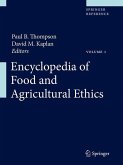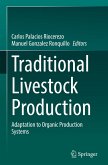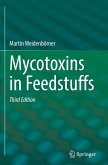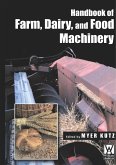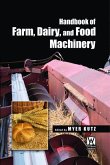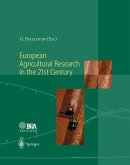Intensive Livestock Production in Transition
Analyses, Concepts and Strategies for Sustainability Transformation of the Livestock Value Chain
Herausgegeben:Grabkowsky, Barbara; Blaha, Thomas
Intensive Livestock Production in Transition
Analyses, Concepts and Strategies for Sustainability Transformation of the Livestock Value Chain
Herausgegeben:Grabkowsky, Barbara; Blaha, Thomas
- Gebundenes Buch
- Merkliste
- Auf die Merkliste
- Bewerten Bewerten
- Teilen
- Produkt teilen
- Produkterinnerung
- Produkterinnerung
Areas of intensive livestock production are currently facing a significant transformation process. In the context of climate change, the planetary boundaries, political conflicts and crises as well as a growing population, sustainable, effective and resilient agrifood systems need to be established. To achieve this goal, society, politics, the economy, agriculture and science are equally challenged. Only with a holistic, systemic and participatory strategy, a transformation of the existing system can be achieved. This book analyses the current transition processes as well as its drivers and…mehr
Andere Kunden interessierten sich auch für
![Encyclopedia of Food and Agricultural Ethics Encyclopedia of Food and Agricultural Ethics]() Encyclopedia of Food and Agricultural Ethics917,99 €
Encyclopedia of Food and Agricultural Ethics917,99 €![Traditional Livestock Production Traditional Livestock Production]() Traditional Livestock Production129,99 €
Traditional Livestock Production129,99 €![Mycotoxins in Feedstuffs Mycotoxins in Feedstuffs]() Martin WeidenbörnerMycotoxins in Feedstuffs164,99 €
Martin WeidenbörnerMycotoxins in Feedstuffs164,99 €![Handbook of Farm, Dairy and Food Machinery Handbook of Farm, Dairy and Food Machinery]() Myer KutzHandbook of Farm, Dairy and Food Machinery228,99 €
Myer KutzHandbook of Farm, Dairy and Food Machinery228,99 €![Evaluation of double recirculating aquaponic systems for intensive plant production Evaluation of double recirculating aquaponic systems for intensive plant production]() Johanna SuhlEvaluation of double recirculating aquaponic systems for intensive plant production69,90 €
Johanna SuhlEvaluation of double recirculating aquaponic systems for intensive plant production69,90 €![Handbook of Farm, Dairy and Food Machinery Handbook of Farm, Dairy and Food Machinery]() Myer KutzHandbook of Farm, Dairy and Food Machinery228,99 €
Myer KutzHandbook of Farm, Dairy and Food Machinery228,99 €![European Agricultural Research in the 21st Century European Agricultural Research in the 21st Century]() PaillotinEuropean Agricultural Research in the 21st Century115,99 €
PaillotinEuropean Agricultural Research in the 21st Century115,99 €-
-
-
Areas of intensive livestock production are currently facing a significant transformation process. In the context of climate change, the planetary boundaries, political conflicts and crises as well as a growing population, sustainable, effective and resilient agrifood systems need to be established. To achieve this goal, society, politics, the economy, agriculture and science are equally challenged. Only with a holistic, systemic and participatory strategy, a transformation of the existing system can be achieved. This book analyses the current transition processes as well as its drivers and barriers and gives examples for new integrated strategies, concepts, business models and developments for the livestock sector. Finally, the book indicates fields of action for the establishment of sustainable livestock farming. The book will appeal to stakeholders in science, society, economy, policy, agricultural industry, stakeholders in veterinary practice and agriculture.
Produktdetails
- Produktdetails
- Verlag: Springer / Springer Nature Switzerland / Springer, Berlin
- Artikelnr. des Verlages: 978-3-031-97871-5
- Seitenzahl: 521
- Erscheinungstermin: 7. Dezember 2025
- Englisch
- Abmessung: 235mm x 155mm
- ISBN-13: 9783031978715
- ISBN-10: 3031978714
- Artikelnr.: 74304939
- Herstellerkennzeichnung
- Libri GmbH
- Europaallee 1
- 36244 Bad Hersfeld
- gpsr@libri.de
- Verlag: Springer / Springer Nature Switzerland / Springer, Berlin
- Artikelnr. des Verlages: 978-3-031-97871-5
- Seitenzahl: 521
- Erscheinungstermin: 7. Dezember 2025
- Englisch
- Abmessung: 235mm x 155mm
- ISBN-13: 9783031978715
- ISBN-10: 3031978714
- Artikelnr.: 74304939
- Herstellerkennzeichnung
- Libri GmbH
- Europaallee 1
- 36244 Bad Hersfeld
- gpsr@libri.de
Dr. rer. nat. Barbara J. Grabkowsky is director of the "Center of sustainability transformation in agrifood systems" at the University of Vechta in Northwest Germany. She holds a degree in environmental sciences and a PhD in food safety, risk assessment and disease prevention in livestock systems. In her 10 years research experience, she was involved in numerous international research projects, committees and working groups in fields of One Health, communication and food safety at universities in the Netherlands, Italy, Hungary and Germany. Subsequently, she worked for seven years in leading positions in the agrifood business in the field of sustainability management and resource efficiency in the agrifood sector. For the last five years, she has been back in the research field and is working on - Transformation processes in regions of intensive agriculture in Europe - Sustainability concepts for resilient agrifood systems - Education concepts for change management and transformative literacy - Participatory concepts for sustainability education in living labs She is member of working groups of the European Food Safety Authority (EFSA) on biosecurity, food safety and interdisciplinary sector involvement in Parma and the FAO in Rome and acclaimed speaker on international and national conferences and symposia. ¿Prof. Dr. med. vet. Thomas Blaha (Dipl. ECPHM and ECVPH) - Professor emeritus at the Foundation of the University of Veterinary Medicine in Hanover, Germany for epidemiology in Bakum, with five years as a university professor in Minnesota - Since 2007 Chairman of the Veterinary Association for Animal Protection (TVT). - Editor/author of more than 250 scientific articles and three books (ed.) on animal health and welfare - Diplomate of the European College of Veterinary PublicHealth (ECVPH) as well as founding member and Diplomate of the European College of Porcine Health Management (ECPHM) - Member of the Animal Welfare Working Group (AWWG) of the European Federation of Veterinarians of Europe (FVE) - Several times member of ad-hoc working groups of the European Food Safety Authority (EFSA) in Parma - Former President of the International Society of Animal Hygiene
Chapter 1: Introduction.- Chapter 2: Changing the Goal from Maximizing Financial to Optimizing Sustainable Return on Investment for the Future of Livestock and Food Production, People, Ecosystems, and the Planet.- Chapter 3: Intensive livestock production: mechanisms and structures.- Chapter 4: Ecological footprint of livestock production.- Chapter 5: The transformation of livestock production in a globalised world barriers and opportunities.- Chapter 6: Public ethical discourse about livestock production.- Chapter 7: Systemic complexity makes the transformation a "wicked problem.- Chapter 8: Improving Animal Welfare and Animal Health.- Chapter 9: Economic and political competitive constraints to improving animal welfare.- Chapter 10: Introduction - The Relevance of maintaining the highest possible food safety standards in the transformation process.- Chapter 11: The Relevance of the highest possible biosecurity systems in the transformation process - Conclusion.- Chapter 12: Transformative change towards responsible water management and sustainable livestock production.- Chapter 13: Potential of functional plant diversity for climate resilience of grasslands.- Chapter 14: Upcycling food loss and waste to animal feed is essential for a circular and sustainable food system.- Chapter 15: By-products from agriculture and agro-food industry for livestock nutrition.- Chapter 16: Future livestock systems based on circularity.- Chapter 17: Specificities, changes and challenges of pig production in France.- Chapter 18: A dichotomous approach to extensive and intensive animal farming.- Chapter 19: Potential of digital technologies for transforming livestock production.- Chapter 20: Making sustainability our business: Entre- and intrapreneurial activities to develop new pathways for a sustainable agricultural sector.- Chapter 21: Transformation-Literate Citizens: Advancing Sustainable Development through Education.- Chapter 22: Consumer-oriented perspectives for sustainable animal products and consumption.- Chapter 23: The consumer as a change agent in the green transition of the food sector.- Chapter 24: The Role of Sustainable Food Labels in Transforming the Food System.- Chapter 25: Future requirements for animal husbandry structures.- Chapter 26: Areas of responsibilities (who has to take responsibility for what) for the well-being of food animals.- Chapter 27: How to govern the transition to sustainable animal husbandry in high-income open economies?.- Chapter 28: The Transformation Framework: Lessons Learned, Integrating Ecological Limits, Systemic Drivers, and Economic Viability.- Chapter 29: The transition of agri-food systems is a task for society as a whole.- Chapter 30: Multi-Stakeholder Governance in Agricultural Policy: Insights from the Commission on the Future of Agriculture in Germany.- Chapter 31: Sustainable transformation of intensive livestock production systems IS NOT a return to Old McDonald s farm .
Chapter 1: Introduction.- Chapter 2: Changing the Goal from Maximizing Financial to Optimizing Sustainable Return on Investment for the Future of Livestock and Food Production, People, Ecosystems, and the Planet.- Chapter 3: Intensive livestock production: mechanisms and structures.- Chapter 4: Ecological footprint of livestock production.- Chapter 5: The transformation of livestock production in a globalised world barriers and opportunities.- Chapter 6: Public ethical discourse about livestock production.- Chapter 7: Systemic complexity makes the transformation a "wicked problem.- Chapter 8: Improving Animal Welfare and Animal Health.- Chapter 9: Economic and political competitive constraints to improving animal welfare.- Chapter 10: Introduction - The Relevance of maintaining the highest possible food safety standards in the transformation process.- Chapter 11: The Relevance of the highest possible biosecurity systems in the transformation process - Conclusion.- Chapter 12: Transformative change towards responsible water management and sustainable livestock production.- Chapter 13: Potential of functional plant diversity for climate resilience of grasslands.- Chapter 14: Upcycling food loss and waste to animal feed is essential for a circular and sustainable food system.- Chapter 15: By-products from agriculture and agro-food industry for livestock nutrition.- Chapter 16: Future livestock systems based on circularity.- Chapter 17: Specificities, changes and challenges of pig production in France.- Chapter 18: A dichotomous approach to extensive and intensive animal farming.- Chapter 19: Potential of digital technologies for transforming livestock production.- Chapter 20: Making sustainability our business: Entre- and intrapreneurial activities to develop new pathways for a sustainable agricultural sector.- Chapter 21: Transformation-Literate Citizens: Advancing Sustainable Development through Education.- Chapter 22: Consumer-oriented perspectives for sustainable animal products and consumption.- Chapter 23: The consumer as a change agent in the green transition of the food sector.- Chapter 24: The Role of Sustainable Food Labels in Transforming the Food System.- Chapter 25: Future requirements for animal husbandry structures.- Chapter 26: Areas of responsibilities (who has to take responsibility for what) for the well-being of food animals.- Chapter 27: How to govern the transition to sustainable animal husbandry in high-income open economies?.- Chapter 28: The Transformation Framework: Lessons Learned, Integrating Ecological Limits, Systemic Drivers, and Economic Viability.- Chapter 29: The transition of agri-food systems is a task for society as a whole.- Chapter 30: Multi-Stakeholder Governance in Agricultural Policy: Insights from the Commission on the Future of Agriculture in Germany.- Chapter 31: Sustainable transformation of intensive livestock production systems IS NOT a return to Old McDonald s farm .


